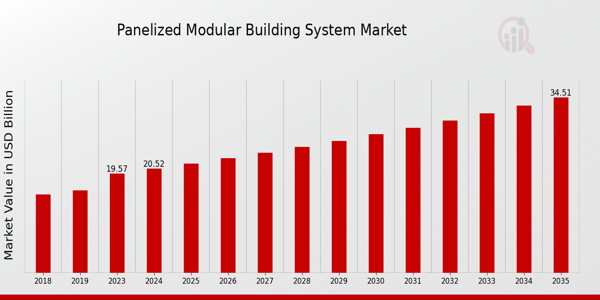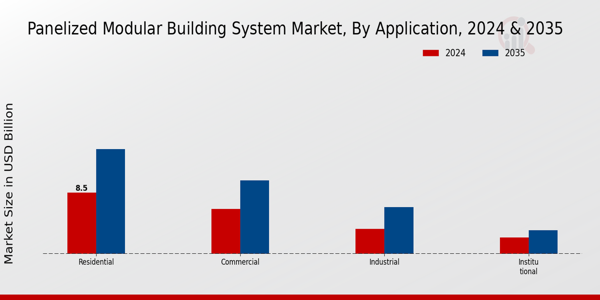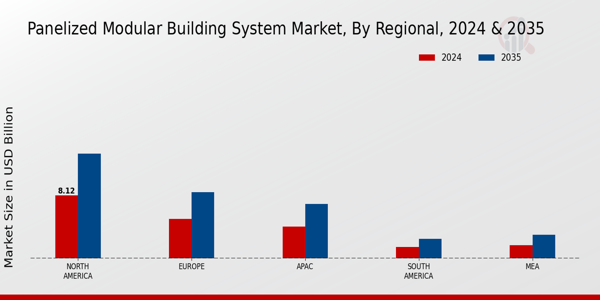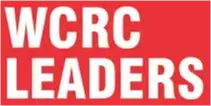Global Panelized Modular Building System Market Overview
The Panelized Modular Building System Market Size was estimated at 19.57 (USD Billion) in 2023. The Panelized Modular Building System Industry is expected to grow from 20.52 (USD Billion) in 2024 to 34.5 (USD Billion) by 2035. The Panelized Modular Building System Market CAGR (growth rate) is expected to be around 4.84% during the forecast period (2025 - 2035).
Key Panelized Modular Building System Market Trends Highlighted
The Panelized Modular Building System Market is driven by several key factors that contribute to its growth. The increasing demand for efficient construction methods that save time and reduce labor costs is a significant market driver. Sustainability and eco-friendliness are also shaping this market as environmentally conscious practices become more important in construction. Additionally, the rise in urbanization and population growth has created a need for more housing and commercial space, further propelling the adoption of modular building systems. These systems provide quick solutions to meet this demand, allowing for faster project completion and reduced waste.The integration of new technologies into modular systems maximizes their effectiveness and resource efficiency. Additionally, emerging markets enable new growth avenues. Now, more countries are turning towards incidences of modular construction and investment, and clientele development on a level is likely to increase. This shift could theoretically impact the general construction industry. In recent years, there has been a noticeable increase in the level of personalization of modular building designs; clients are now more closely and directly involved in their projects. Also, it is increasingly common to see modular builders collaborating with traditional construction companies to create a new flexible methodology that incorporates the advantages of the two approaches. The focus on sustainability is leading to an emphasis on using recycled materials and energy-efficient practices in modular construction. Overall, these factors contribute to a dynamic landscape in the Panelized Modular Building System Market, presenting both challenges and opportunities for stakeholders.

Panelized Modular Building System Market Drivers
Sustainability and Environmental Concerns
The increasing focus on sustainability and reducing the environmental impact of construction has become a significant driver for the Panelized Modular Building System Market Industry. As climate change continues to be a pressing issue, companies and individuals are looking for ways to minimize their carbon footprints. Panelized modular building systems are recognized for their efficiency in using materials, generating less waste during construction, and allowing for faster assembly and disassembly.This approach significantly decreases the time required for construction, which translates to lower energy consumption on-site. Additionally, many panelized modular solutions incorporate eco-friendly materials that are sourced sustainably, further appealing to environmentally conscious consumers and businesses. As legislation evolves to favor sustainable building practices, the adoption of modular systems that offer both environmental benefits and cost-effectiveness will continue to rise. This trend is critical for the future of the Panelized Modular Building System Market, as it aligns with broader goals of creating resilient and energy-efficient buildings that meet modern demands while promoting sustainability.
Rapid Urbanization and Housing Shortages
Rapid urbanization and the subsequent housing shortages experienced in many regions around the world are crucial drivers for the Panelized Modular Building System Market Industry. As populations continue to grow and migrate toward urban centers, the demand for affordable housing increases significantly. Modular building systems offer a promising solution to this pressing issue by enabling quicker construction timelines, which helps meet urgent housing demands.The efficiency of these systems also allows for the use of more flexible designs that can adapt to different urban spaces, making them suitable for a variety of urban development projects. As cities seek innovative ways to cope with their growing populations and infrastructure challenges, panelized modular buildings provide a viable answer that aligns with contemporary urban planning strategies.
Technological Advancements in Construction
Technological advancements in construction processes and materials are reshaping the Panelized Modular Building System Market Industry significantly. Innovations such as robotics, 3D printing, and advanced materials science are making modular construction more efficient and cost-effective. These technologies enable faster production, enhanced precision, and improved quality of the building components, which ultimately leads to shorter project timelines and reduced labor costs.Moreover, the integration of smart technologies within modular designs contributes to energy efficiency and better resource management in buildings. As more companies adopt these cutting-edge technologies, the overall performance and appeal of modular building systems will increase, driving growth in the market as a result.
Panelized Modular Building System Market Segment Insights
Panelized Modular Building System Market Application Insights
The Panelized Modular Building System Market is experiencing notable growth, particularly in the Application segment, which encompasses Residential, Commercial, Industrial, and Institutional applications. In 2024, the overall valuation of the sector is projected to reach 20.52 USD Billion. Within this landscape, Residential Applications are leading the market with a substantial contribution valued at 8.5 USD Billion, expected to climb to 14.5 USD Billion by 2035. This segment is crucial due to the rising demand for affordable and efficient housing solutions that can be rapidly deployed, making it a cornerstone of the Panelized Modular Building System Market revenue.Commercial applications follow, with a valuation of 6.2 USD Billion in 2024, which is expected to increase to 10.2 USD Billion by 2035. This growth is driven by the demand for customizable office spaces and retail environments that facilitate business operations and enhance customer experiences. Industrial applications are also significant, valued at 3.5 USD Billion in 2024, set to rise to 6.5 USD Billion by 2035. The industrial segment emphasizes the need for flexible manufacturing spaces and efficient storage solutions, reflecting the ongoing trends toward automation and streamlined operations.Institutional applications, though the smallest among the categories, are not to be overlooked, with a valuation of 2.3 USD Billion in 2024, projected to reach 3.3 USD Billion by 2035. This sector caters to schools, hospitals, and other public entities where timely construction can significantly impact service delivery. The overall Panelized Modular Building System Market segmentation showcases a diverse landscape, where the Residential segment holds the majority share, highlighting its crucial role in addressing the housing crisis.As the market evolves, trends such as sustainability and energy efficiency are becoming increasingly relevant across all applications, driving innovation and presenting growth opportunities. However, challenges such as regulatory hurdles and supply chain disruptions remain pertinent issues for the industry. The insights into the various applications within the Panelized Modular Building System Market data reflect the strategic importance of understanding market dynamics to leverage opportunities and address challenges effectively. Understanding these market statistics is essential for stakeholders aiming to navigate the expanding terrain of the Panelized Modular Building System Market industry.

Panelized Modular Building System Market Material Type Insights
The Panelized Modular Building System Market, valued at 20.52 USD Billion in 2024, showcases diverse opportunities within the Material Type segment, which includes Wood, Steel, Concrete, and Composite materials. Each material type plays a critical role in defining the market dynamics, with Wood being particularly valued for its sustainability and ease of construction, leading to its significant adoption in residential projects. Steel is recognized for its strength and durability, dominating in commercial applications, while Concrete is often sought after for its fire-resistance and thermal mass properties, making it essential for multi-story structures.Composite materials are increasingly gaining traction due to their versatility and reduced weight, offering solutions that combine the benefits of other materials. The Panelized Modular Building System Market segmentation highlights how these materials contribute to market growth, driven by trends in sustainability, innovation in construction technologies, and increased urbanization. Despite facing challenges such as material costs and supply chain disruptions, the ongoing demand for efficient and sustainable building solutions presents significant opportunities for manufacturers and investors within the market.
Panelized Modular Building System Market Construction Method Insights
The Panelized Modular Building System Market is projected to experience growth, with a valuation of 20.52 USD Billion in 2024. This growth can be attributed to various construction methods employed in the market, including Off-site, On-site, and Hybrid Construction. Off-site construction is recognized for its efficiency and shortened project timelines, as components are pre-fabricated in controlled environments. On-site construction allows for flexibility and adaptability, catering to specific site conditions; however, it might lead to longer timelines.Hybrid construction combines elements from both off-site and on-site techniques, capitalizing on the strengths of each to optimize costs and time. The market growth is driven by the increasing demand for faster construction methods, sustainable practices, and the rising need for affordable housing solutions. However, challenges such as regulatory hurdles and the necessity for skilled labor can impact the pace. The Panelized Modular Building System Market data indicates these construction methods are key to the industry’s evolution and address diverse customer needs effectively. As a result, understanding these methods provides valuable insights into market dynamics and growth opportunities.
Panelized Modular Building System Market End Use Insights
The Panelized Modular Building System Market revenue is projected to reach 20.52 USD Billion in 2024, reflecting a robust forecast for the sector. The End Use segment is a critical aspect of this market, which comprises Temporary Structures and Permanent Structures. Temporary Structures typically cater to short-term needs, such as construction site offices and pop-up facilities, and have gained traction due to their rapid deployment capabilities and cost efficiency. In contrast, Permanent Structures are increasingly favored for their long-term investment potential and adaptability in residential and commercial spaces.These structures have seen major growth, attributed to the rising demand for sustainable building practices and efficient construction timelines. The combination of these two segments showcases a balanced market growth driven by innovative modular designs and a focus on reducing construction time and costs. The emphasis on versatility in the construction process leads to significant improvements in efficiency and resource management within the Panelized Modular Building System Market. As various industries continue to recognize the benefits, particularly within the education, healthcare, and hospitality sectors, the market dynamics remain supportive of opportunity-rich scenarios that can influence future trends and developments.
Panelized Modular Building System Market Regional Insights
The Regional segment of the Panelized Modular Building System Market is poised for substantial growth, with North America leading the charge, showcasing a valuation of 8.12 USD Billion in 2024 and expected to reach 13.47 USD Billion by 2035, indicating its dominant position in the market. Europe follows with a significant valuation of 5.1 USD Billion in 2024 and projected growth to 8.5 USD Billion, highlighting its relevance in industrial applications. The APAC region is also crucial, valued at 4.1 USD Billion in 2024 and anticipated to grow to 7.0 USD Billion, driven by rapid urbanization and construction activities.South America and the MEA regions have smaller market sizes, with values of 1.5 USD Billion and 1.7 USD Billion in 2024, respectively, but demonstrate remarkable potential for growth, with South America reaching 2.5 USD Billion and MEA at 3.03 USD Billion by 2035. The varying market sizes across these regions reflect trends such as infrastructural investments and urban expansion, fueling the demand for modular building systems ly. Each region's unique dynamics contribute to the overall Panelized Modular Building System Market revenue, ensuring diverse opportunities for industry participants.

Panelized Modular Building System Market Key Players and Competitive Insights
The Panelized Modular Building System Market is characterized by dynamic developments and diverse players striving to establish a strong foothold in this evolving sector. A variety of products, innovative technologies, and sustainable practices are propelling the demand for modular construction solutions, which offer speed, efficiency, and adaptability compared to traditional building processes. This market has witnessed a surge in interest from construction companies, developers, and investors keen on addressing the growing need for housing and commercial spaces. As the market grows, the competition between established and emerging players becomes more pronounced, prompting companies to enhance their offerings while investing in research and development to stay ahead. The emphasis on sustainability, increased focus on cost-effective solutions, and advancements in manufacturing techniques significantly contribute to the competitive landscape of the market.Lendlease has carved out a strong presence in the Panelized Modular Building System Market by leveraging its extensive experience and commitment to innovative construction methods. Renowned for its focus on design excellence and sustainable practices, Lendlease has successfully integrated modular solutions into many of its projects. The company's strengths lie in its robust supply chain management and ability to scale operations efficiently, allowing it to respond effectively to varying project demands. Furthermore, Lendlease's investment in advanced technology and digital solutions not only streamlines processes but also minimizes environmental impact. This strategic approach positions Lendlease as a formidable competitor, capable of delivering high-quality modular buildings while meeting regulatory requirements and client expectations. Its reputation fosters partnerships with the public and private sectors, further solidifying its influence in the modular building market.Katerra has emerged as a significant player within the Panelized Modular Building System Market, focusing on the intersection of technology and construction. The company specializes in prefabrication and modular construction, gaining recognition for its unique approach to design and manufacturing. Katerra’s strengths revolve around its integrated model, bringing together design, materials, and construction under one roof, creating streamlined processes that enhance efficiency and reduce delivery times. This holistic approach enables Katerra to offer end-to-end solutions that cater to various segments, including residential and commercial developments. Additionally, the company emphasizes sustainability through its use of off-site fabrication techniques that minimize waste and optimize resource use. Katerra's commitment to innovation and efficiency positions it well within the competitive landscape, making it a notable contender in the ever-evolving modular building market.
Key Companies in the Panelized Modular Building System Market Include
Panelized Modular Building System Market Industry Developments
Recent developments in the Panelized Modular Building System Market reflect a growing trend toward sustainability and efficiency in construction. Companies like Lendlease and Tishman Realty & Construction are increasingly focusing on environmentally friendly practices within their modular projects. Katerra continues to expand its offerings to cater to both residential and commercial segments while emphasizing speed and cost-effectiveness. Shah Construction and Laing O'Rourke are investing in innovative technologies to enhance their modular building capabilities, improving overall project delivery timelines. Notably, Z Modular has recently partnered with various contractors to boost its supply chain efficiency, which is vital for scalability. In terms of market dynamics, firms such as BAM Construct UK and McGraw Hill Construction project a significant increase in market valuation due to rising demand for affordable housing solutions. Furthermore, recent mergers and acquisitions have emerged within this sector as companies like Skanska and VBC look to enhance their competitive positioning through strategic collaborations. This consolidation trend is expected to further drive innovation and improve service offerings across the panelized modular building landscape, influencing future growth prospects.
Panelized Modular Building System Market Segmentation Insights
Panelized Modular Building System Market Application Outlook
-
Residential
-
Commercial
-
Industrial
-
Institutional
Panelized Modular Building System Market Material Type Outlook
-
Wood
-
Steel
-
Concrete
-
Composite
Panelized Modular Building System Market Construction Method Outlook
-
Off-site Construction
-
On-site Construction
-
Hybrid Construction
Panelized Modular Building System Market End Use Outlook
-
Temporary Structures
-
Permanent Structures
Panelized Modular Building System Market Regional Outlook
-
North America
-
Europe
-
South America
-
Asia Pacific
-
Middle East and Africa
| Report Attribute/Metric |
Details |
| Market Size 2023 |
19.57 (USD Billion) |
| Market Size 2024 |
20.52 (USD Billion) |
| Market Size 2035 |
34.5 (USD Billion) |
| Compound Annual Growth Rate (CAGR) |
4.84% (2025 - 2035) |
| Report Coverage |
Revenue Forecast, Competitive Landscape, Growth Factors, and Trends |
| Base Year |
2024 |
| Market Forecast Period |
2025 - 2035 |
| Historical Data |
2019 - 2024 |
| Market Forecast Units |
USD Billion |
| Key Companies Profiled |
Lendlease, Katerra, Shah Construction, Tishman Realty and Construction, Laing O'Rourke, Z Modular, BAM Construct UK, McGraw Hill Construction, Modular Building Institute, VBC, Kiewit Corporation, Perkins + Will, Factory OS, Skanska |
| Segments Covered |
Application, Material Type, Construction Method, End Use, Regional |
| Key Market Opportunities |
Sustainability-driven construction demand, Urbanization and infrastructure spending, Technological advancements in fabrication, Customization and design flexibility, Cost-effective housing solutions |
| Key Market Dynamics |
Sustainability and environmental impact, Cost efficiency and savings, Speed of construction, Customization and flexibility, Technological advancements and innovation |
| Countries Covered |
North America, Europe, APAC, South America, MEA |
Frequently Asked Questions (FAQ) :
The Panelized Modular Building System Market is expected to be valued at 20.52 USD Billion in 2024.
By 2035, the Panelized Modular Building System Market is projected to reach 34.5 USD Billion.
The expected CAGR for the Panelized Modular Building System Market between 2025 and 2035 is 4.84%.
North America is expected to dominate the Panelized Modular Building System Market with a value of 8.12 USD Billion in 2024.
The Residential application segment of the Panelized Modular Building System Market is valued at 8.5 USD Billion in 2024.
The Commercial application segment is estimated to be valued at 10.2 USD Billion by 2035.
Key players in the Panelized Modular Building System Market include Lendlease, Katerra, and Tishman Realty and Construction.
The Industrial application segment is expected to reach 6.5 USD Billion by 2035, showing a steady growth from 2024.
The APAC region is valued at 4.1 USD Billion in the Panelized Modular Building System Market for 2024.
Challenges include fluctuating raw material costs and regulatory hurdles impacting the growth of the Panelized Modular Building System Market.





























